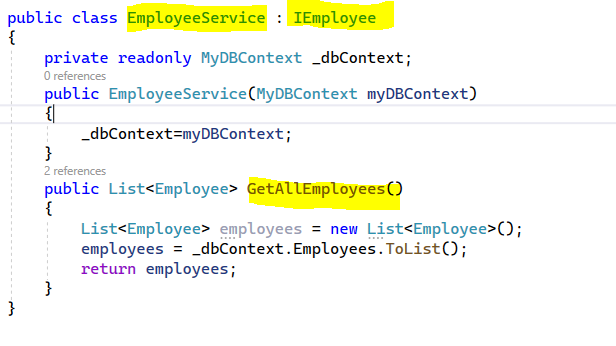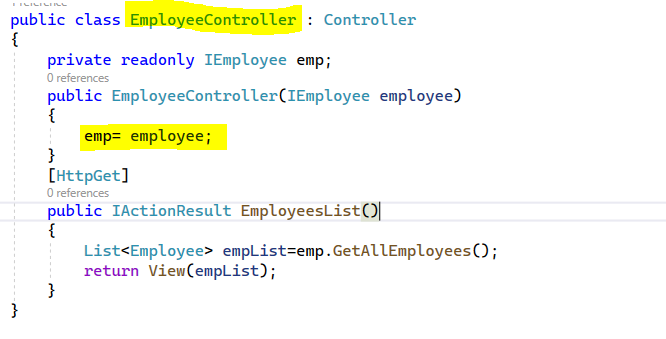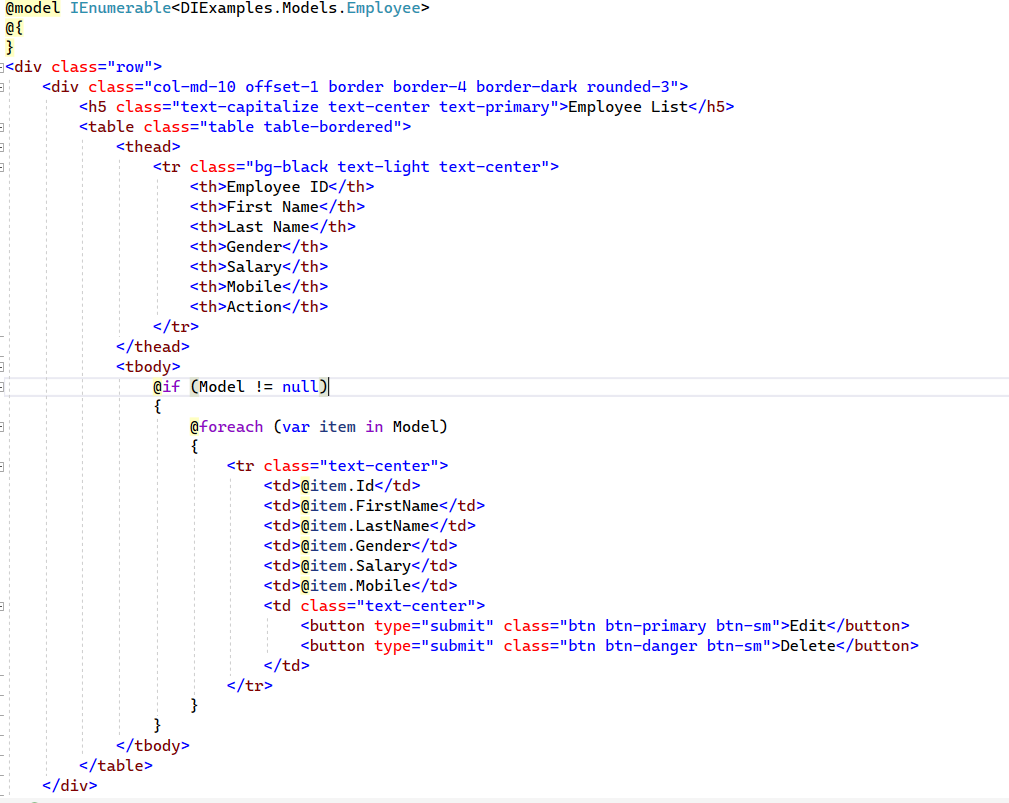- Model or Input validation in ASP.Net Core
- Basics of ASP.Net Core
- Caching in ASP.Net Core
- Nunit Test for Model Validation
- Serilog in Web API to Store Logs
- Web API Crud using Stored Procedures
- Auto Mapper in ASP.Net Core
- Crud on Bulk Data
- Import Data Excel to DB
- Export Data in Excel
- ViewBag in MVC Core
- ViewData in MVC Core
- Service Lifetime in MVC Core
- LINQ Queries
- JWT Token in ASP Core
- ViewModel in MVC
- Custom MiddileWare
- Global Exception Handling using Custom Middileware
- Dropdownlist in ASP Core
- Authentication in MVC
- MVC Crud with ADO
- Paging in MVC
- Casecading Dropdown
- First React Project
- Hooks in React
- React Crud with API Core
- Save Image in DB
- MVC Core Charts
- State Management
- Session in ASP Core
- Design Patterns
- Singleton Pattern
- Dependency Injection
- Keyed Services Dependency Injection
- Repository Pattern
- Factory Pattern
Repository Patterns in C#.
Repository Patterns :- Repository Patterns is a Software Design Pattern and widely used in software developments. It provides abstraction of database operations from other software components or we can say that it is a Abstraction of Data Access Layer.
Using the Repository Patterns we can hide the details of how data is manipulated from underlying datasource into the application.
It simply means we have to write the data manipulation logic into the seperate repository that we can change easily when data source is changed
for the application then only we have to write the logic in single place.
With Repository Patterns we can easily enables the future changes and applied it in very easy way without more modifications of existing code
that is written in data access layer..
To implement Repository Pattern we have to follow below steps :-
- Create a Interface Repository in which declare the data manipulation methods.
- Create a service class and implement the Interface into this Service class and provides the complete implementation to methods that is declared in Interface Repository and used for Data Manipulation operations from different data sources.
- Create a Constructor into the Controller class and pass the Repository interface as a parameter into the Constructor and create a private readonly property of Interface repository and call the required methods from Service Class.
Practical Implementation for Repository Pattern :- For implementing the Repository Pattern in application firstly I have created a Interface IEmployee in which i have declare a method GetAllEmployees() and it is returning the List of Employee.So before creation of Interface create a Model Class and named it as Employee as shown in below code snippet.
public class Employee
{
[Key]
public int Id { get; set; }
public string FirstName { get; set; }
public string LastName { get; set; }
public string Gender { get; set; }
public int Salary { get; set; }
public string Mobile { get; set; }
}
As shown in above code I have created a Employee Model Class and after it I have created a Interface named it IEmployee that you can find into below code snippet.
public interface IEmployee
{
List GetAllEmployees();
}
After creating a Interface now I have created a EmployeeService Class and implements the Interface into it and provides the implementation of GetAllEmployees() Method into this class.
public class EmployeeService : IEmployee
{
private readonly MyDBContext _dbContext;
public EmployeeService(MyDBContext myDBContext)
{
_dbContext=myDBContext;
}
public List GetAllEmployees()
{
List employees = new List();
employees = _dbContext.Employees.ToList();
return employees;
}
}
After creating the Service Class and Interface we have to register this services into the Program.cs file with any one of the Service Life time methods(like AddScoped,AddSingleton,AddTransient) with Interface and Service class as depicted into the below code example.
using DIExamples.Repository;
using DIExamples.Services;
var builder = WebApplication.CreateBuilder(args);
// Add services to the container.
builder.Services.AddScoped();
builder.Services.AddControllersWithViews();
var app = builder.Build();
// Configure the HTTP request pipeline.
if (!app.Environment.IsDevelopment())
{
app.UseExceptionHandler("/Home/Error");
app.UseHsts();
}
app.UseHttpsRedirection();
app.UseStaticFiles();
app.UseRouting();
app.UseAuthorization();
app.MapControllerRoute(
name: "default",
pattern: "{controller=Employees}/{action=EmployeeList}/{id?}");
app.Run();
In the above code examples you can find the Repository Patterns implementations ,I am going to explain here in more details.
I have created a Repository Interface and Service class for database access layer abstraction. In EmployeeService class I have created a Method
that is fetching all the employees from database and returning a Employee List and again this services we are going to use in Controller class
so it is providing the complete loosely coupled system.Below code is attached for Employee Controller class.
public class EmployeeController : Controller
{
private readonly IEmployee emp;
public EmployeeController(IEmployee employee)
{
emp= employee;
}
[HttpGet]
public IActionResult EmployeesList()
{
List empList=emp.GetAllEmployees();
return View(empList);
}
}
Below is some screen images that I have attached for your reference and with these images you can easily understand the steps that we required for implementing the Repository Pattern and example code also. Below is the image for Employee Service Class.

Image of Program.cs file using the AddScoped services.

Image of Controller Class having a Constructor and Repository Interface is passed as a parameter.

Image of code for cshtml file that is used for representing the Employee data.

Image of final View that is used for representing the Employee data.

Note :- In the above code example I did not included the Migration Process for creating the database entities from Model Class, you can use the EntityFrameworkCore Code first approach. If you are not aware about the migration process then you can find it below.
Add the connection string into the appSettings.JSON file as shown in below image in which CorePracticeDB is the name of the database we want to create for our application.Here we have used local server you can change it by your server name or IP address.

Create a DBContext Class and add Employee as a DbSet and then run the migration commands.In the below code you can find the complete DBContext class.
public class MyDBContext :DbContext
{
public MyDBContext(DbContextOptions options):base(options)
{
}
public DbSet Employees { get; set; }
}

